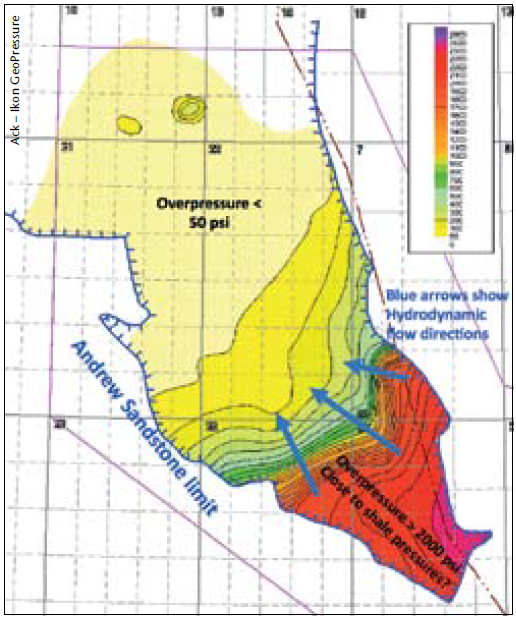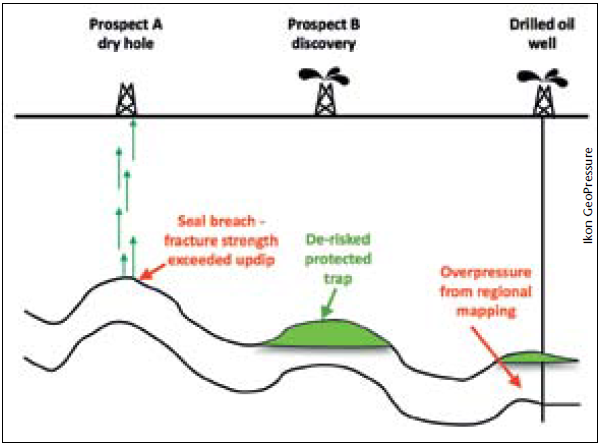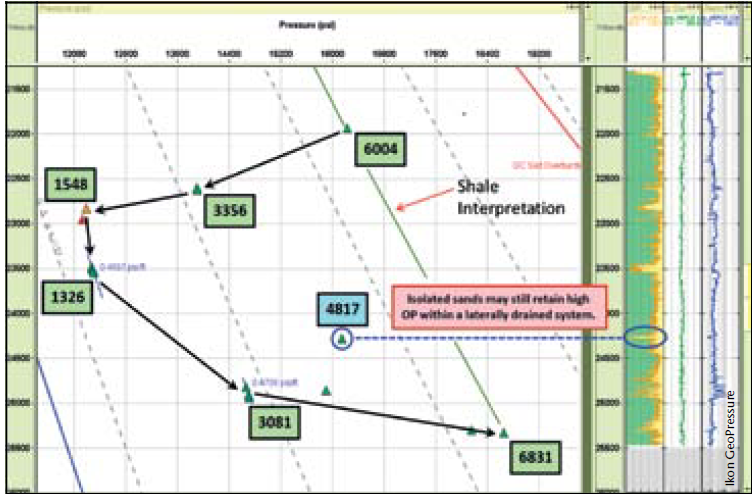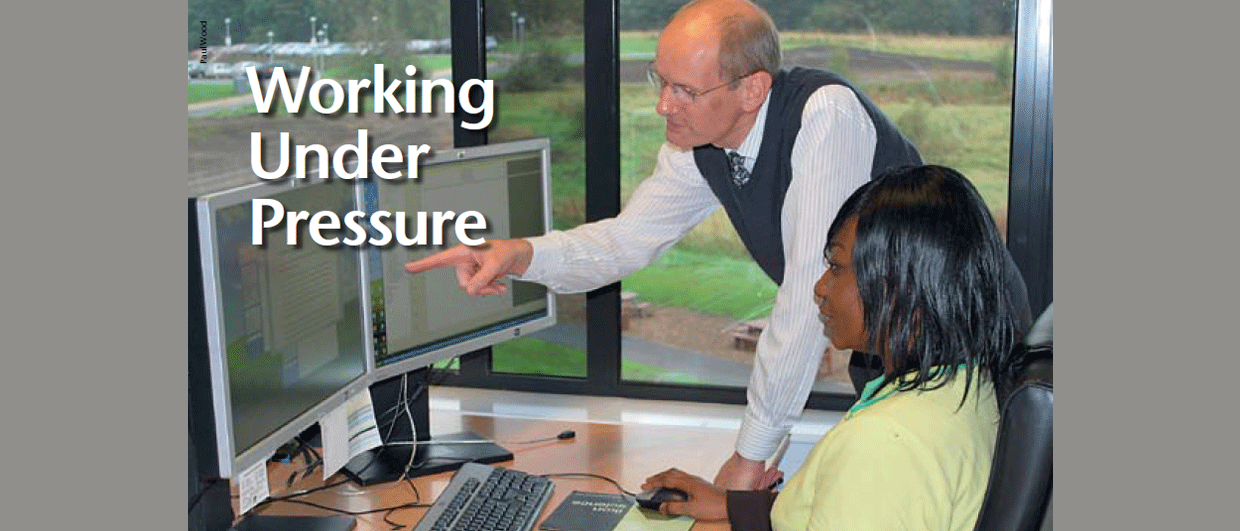Working under pressure may not be everyone’s ideal job, but Richard Swarbrick and his team at Ikon GeoPressure at Durham in the north-east of England are doing it all the time. Or, to be more accurate, working over pressure. Richard studied geology at Durham and Cambridge Universities, then joined Mobil and worked for ten years in the UK and Houston before returning to Durham to teach petroleum geology. During this time at Durham he had a lot of contact with the oil and gas business and realised that, especially in the North Sea, variable and high pressure and temperature conditions in some reservoirs were not only a hazard but a barrier to effective development of the reserves.
Pressure Prediction Workflow

In 2003, GeoPressure Technology established a robust pressure prediction workflow for the Central North Sea. In the Jurassic and Tertiary formations, fluid pressures are high, requiring high mud weights, but too much pressure in the mud column could fracture the rocks. The resultant narrow drilling window, combined with drilling difficulties in the chalk, meant that pressure prediction was vital and this work soon became the bread and butter of the company. Richard says, “I developed the catch-phrase ‘the regional informs the local’ to point out that it was necessary to study pressures on a regional scale in order to make specific local predictions.” Working from the regional picture and then focusing on the detail, his team established the relationship between regional pressure trends and localised pressure cells.Regional studies are important because the North Sea, Mid Norway and the Barents Sea are not amenable to using seismic for pressure prediction, a standard method in areas of young, clastic rocks (like sand and shale mixes). Chemical processes destroy the relationship between porosity and velocity. But if there are many wells, perhaps thousands, it is possible to derive trends and then apply them locally once the regional geology is understood in terms of fluid flow.
Hydrodynamic Flow
During this work in deep Central North Sea formations, it was revealed that many reservoirs experience hydrodynamic flow – slow water movement that created tilted hydrocarbon/water contacts. In hydrodynamic systems, oil and gas can be trapped in a different configuration than a ‘conventional’ hydrocarbon trap with a flat hydrocarbon/water contact. The team has discovered hydrodynamic traps in Paleocene, Cretaceous and Jurassic fields, some of them many years after the fields were originally discovered, where different hydrocarbon/water contacts were previously explained by complex (and most likely flawed) structural interpretations. Examples of hydrodynamic traps which have been inferred using structural models and interpreted by Ikon GeoPressure as hydrodynamic include Ormen Lange (Paleocene, Norway); north flank of Fulmar Field (discovered 1977, Jurassic, Central North Sea); Britannia Field (discovered mid-70s, Cretaceous, Outer Moray Firth, North Sea, published in O’Connor and Swarbrick, 2008).

In 2007, Ikon GeoPressure completed a second regional pressure study, this time of Mid Norway. Although it involved only 200 wells it was a very rich data set. It transpires that the ‘normally pressured’ sector of Mid Norway may only have been like that since the last glaciation. The majority of the main productive units in the Halten Terrace are normally pressured –the question posed previously was “how can these pressures occur within a regional high pressure system?” The study showed that the Jurassic and Tertiary reservoirs were originally part of the regional high pressure system and only lost pressure within the past 20,000 years. This could have occurred during isostatic rebound after withdrawal of the ice. This observation has led to the recognition of de-pressurisation as a geological phenomenon and not just as a result of depletion from production.
Characteristics linked to pressure such as hydrocarbon migration, sealing or reservoir quality can now be considered in the light of a system losing pressure. This is important for safety when drilling, as it is now possible to model a highly pressured shale overburden above laterally drained reservoirs. Commercially it leads to the possibility of longer hydrocarbon columns than with a normally pressured system. If the locations of the pressure systems are known then it is also possible to predict barriers to migration.
Niger Delta Study

In 2010 Ikon GeoPressure started on a pressure study of the deep water Niger Delta area. Richard Swarbrick had presented the North Sea work at a conference in Nigeria, where his overall message was that if you understand the context of pressures and the framework for their distribution then you can focus on safety and commercial aspects. Both of these are paramount in order to exploit deeper prospects in the Niger Delta and have been brought into even sharper focus by the Macondo incident in the Gulf of Mexico, with worldwide ramifications. Six companies pre-committed to the first phase (Deep Water) of the Niger Delta regional study, which allowed the study to be carried out on a regional basis from the start, as data across the Delta were made available by the consortium.
The Niger Delta Study Phase 1 was completed in a year and Richard is very pleased with the technical process and the collaboration with the Nigerian Government and local companies, as well as with the results. Almost all available data (94% of exploration and appraisal wells) were acquired and used and there were no big gaps resulting from the missing wells. The results have been very impressive, providing pressure prediction capability across the deep water region, and showing strong evidence for lateral drainage with implications for hydrodynamic trapping in some connected reservoirs. The pressure study has now started on the continental shelf (Phase 2) and subsequently will examine the swamp and land zones onshore (Phase 3). In both areas the industry is keen to know how to predict pressures in deeper exploration targets below current production levels.
Data Access is Key
The formation of the Niger Delta consortium leads to a question – how much pressure work can be done at an individual company level rather than embarking on multicompany regional studies? As Richard says, “In Norway it may be possible for an individual company to do such work as the data are released after two years. The benefit of using a specialist like Ikon GeoPressure is that the regional work is done once and need not be repeated in-house by all the operators. Analogues are also of great benefit – if work is done in one location, then the results can be taken to another by the specialists.”

But in areas like the Niger Delta or the Gulf of Mexico it is unlikely that a full regional study could be done in-house by a single company. Data access is the key and no one company would have access to all the data. A by-product of the Nigerian pressure study is the creation of a comprehensive data repository for almost all of the Deep Water wells in the Niger Delta, a high-value outcome for the Nigerian petroleum industry. In Europe, energy industry consultants IHS supplied and quality controlled the data for the North Sea and Mid Norway studies, and also for the Barents Sea completed in 2010. Most recently a new West of Shetlands study was finished in late 2011. For the Central North Sea Phase 2, seismic company PGS supplied its mega-merge seismic to help update the model and allow the more detailed, structural mapping of pressure cells.
Solving Complex Pressure Problems
Ikon GeoPressure proprietary projects have ranged from the Arctic to the South Atlantic; from Mauritania to Namibia on the West African coast and from the north coast of America to the Far East and Europe. The company’s speciality is in solving complex pressure problems where traditional methods do not work very well. The focus is on the geological challenges of carbonates, on high pressure – high temperature (HPHT) prospects, examining complex structures and investigating laterally draining reservoirs. Future regional projects are planned in North-West Shelf of Australia and the east coast of Canada. Are they going to get involved with the growing interest in shale gas? Richard says, “Because of the reservoir tightness, identifying pressure before drilling is almost impossible. But we do know there is high pressure down there too! We can only get drilling parameters and information, not suitable log data. The relationship between pressure and sweet spots is not yet known. ‘Difficult conventionals’ such as the sub-salt Wilcox play in the Gulf of Mexico look to be our bread and butter for the immediate future.”
Richard considers that his original company GeoPressure Technology has derived considerable benefit from joining the Ikon Group as the specialism of pressure prediction can now be developed as part of an overall package within the RokDoc software suite. Seismic is now used routinely to derive 3D pore pressure models supported by interpretations in 1 and 2D models from well data. He says, “The relationship with Ikon allows more integration between rock physics and pressure prediction, which differentiates us as a company.” Part of the company’s strength is that it has recruited experienced staff from diverse backgrounds and also graduate staff from an international pool to ‘grow its own’ pore pressure specialists. For the Niger Delta project, Ikon GeoPressure also built a team of five in Lagos to enable technology transfer and build specialist local competence.
The result of building a team of specialists and applying their skills to regional data sets will be an important part of the future pursuit of difficult hydrocarbons. Safety aspects are of course paramount and commercially, implications could lead to improved prospectivity. Prospects could have been missed or drilled in the wrong place, or studies could identify non-structurally trapped hydrocarbons. The studies also look at top seal failure and seal breaches. Looking and exploring within mini-basins for protected traps could lower exploration risks if the pressure relationships are better known.
Richard Swarbrick is very happy with the capabilities he has built in his team and the results they have achieved so far. He sums up: “Our prediction methods are reasonably robust but they are not trivial so they do need specialists. We have analysed the success of our predictions where we know the results of drilling. Considering we focus on the most difficult projects worldwide, our correct prediction rate at higher than 90% speaks for itself.”





